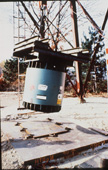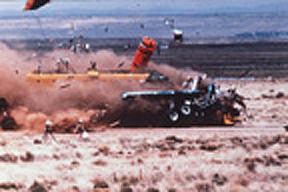Are There Hazards with Food Irradiation?
Today's consumers are increasingly concerned about environmental and worker safety. Since there are about 40 irradiators in the United States and many more world wide, a safety record is readily available.
Shipment of cobalt60 and other radioisotopes is governed by stringent rules and regulations. Cobalt60 is sealed in metal rods and must be shipped in reinforced, double encapsulated metal casks. These casks are designed to withstand the most severe accidents, including collisions, punctures and exposure to fire and water depths.


 Facilities are constructed to standards designed with multiple safeguards to protect worker health and safeguard the community should a natural disaster like an earthquake or tornado occur.
Facilities are constructed to standards designed with multiple safeguards to protect worker health and safeguard the community should a natural disaster like an earthquake or tornado occur.
In the irradiation process there are no hot fluids generated, no radioactive gases released, no way for the facility to experience a melt down and no way that material could be used to produce nuclear weapons.
Facilities following internationally established procedures have never had an accident which endangered the worker or community.
The most common source of energy is cobalt60. Cesium137 is used in some facilities, and some use machine generated energy. A U.S. facility using cesium experienced a leak of radioactive material in 1988. This was cleaned with no damage to the surrounding community (WHO, 1991). Because cesium is soluble in water, it is more difficult to contain. Cesium containers have been modified for greater safety and most store in dry enviroments.
![]() Use of spent radioactive material has also been addressed.
Use of spent radioactive material has also been addressed.
Cobalt used in food irradiation facilities could be "recycled" from that used to sterilize medical facilities. Food uses require very low energy output and medical facilities require high levels to achieve complete sterility.
Only about 10% of cobalt59 is converted to radioactive cobalt60. Instead of storing cobalt60 when the energy rating is low, additional cobalt in the original rod could be converted to cobalt60. This is not done at this time because of technical difficulty, but is theoretically possible.
When the useful life of the cobalt is finally over, it is estimated that all the material produced in North America could be stored in a space the size of an office desk.
As irradiation processing expands, a range of energy sources may be used depending on the application. The USDA is currently evaluating a 8.5' x 10.5' x 12 unit using cesium137 which can be located at a food processing facility. Called Gray Star, this unit uses recycled cesium137 to destroy pathogens. Because of depth of penetration, machine generated or electron beam sources are a more effective treatment on thin products passing along a conveyer belt where pallet loads of food are processed using cobalt or cesium.